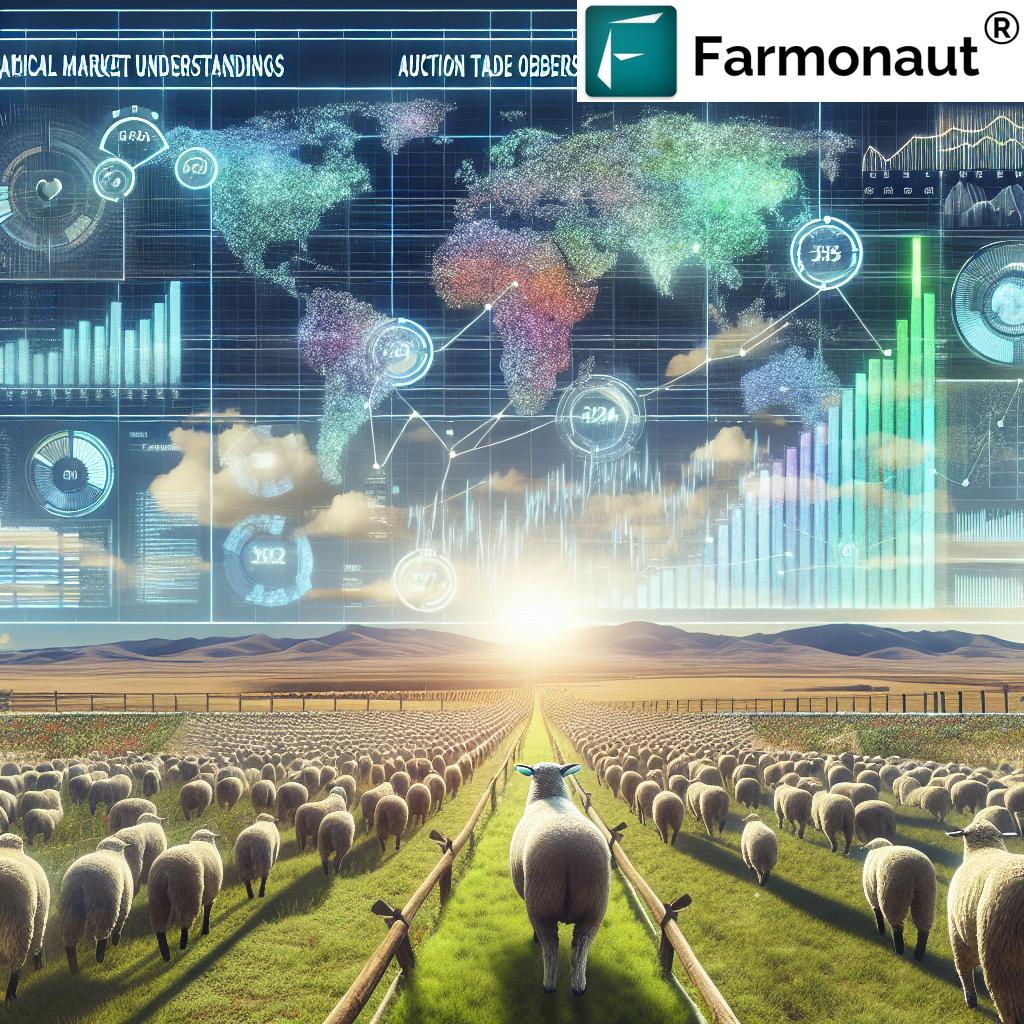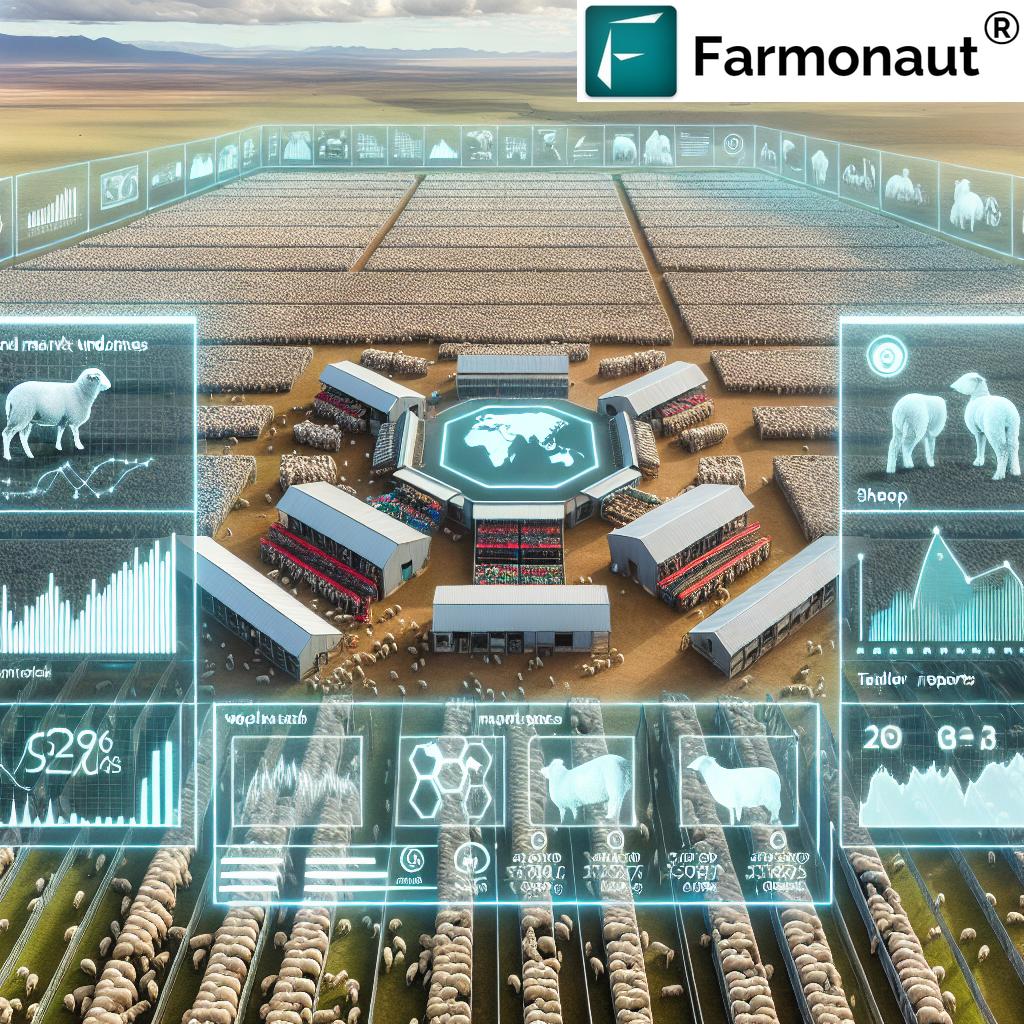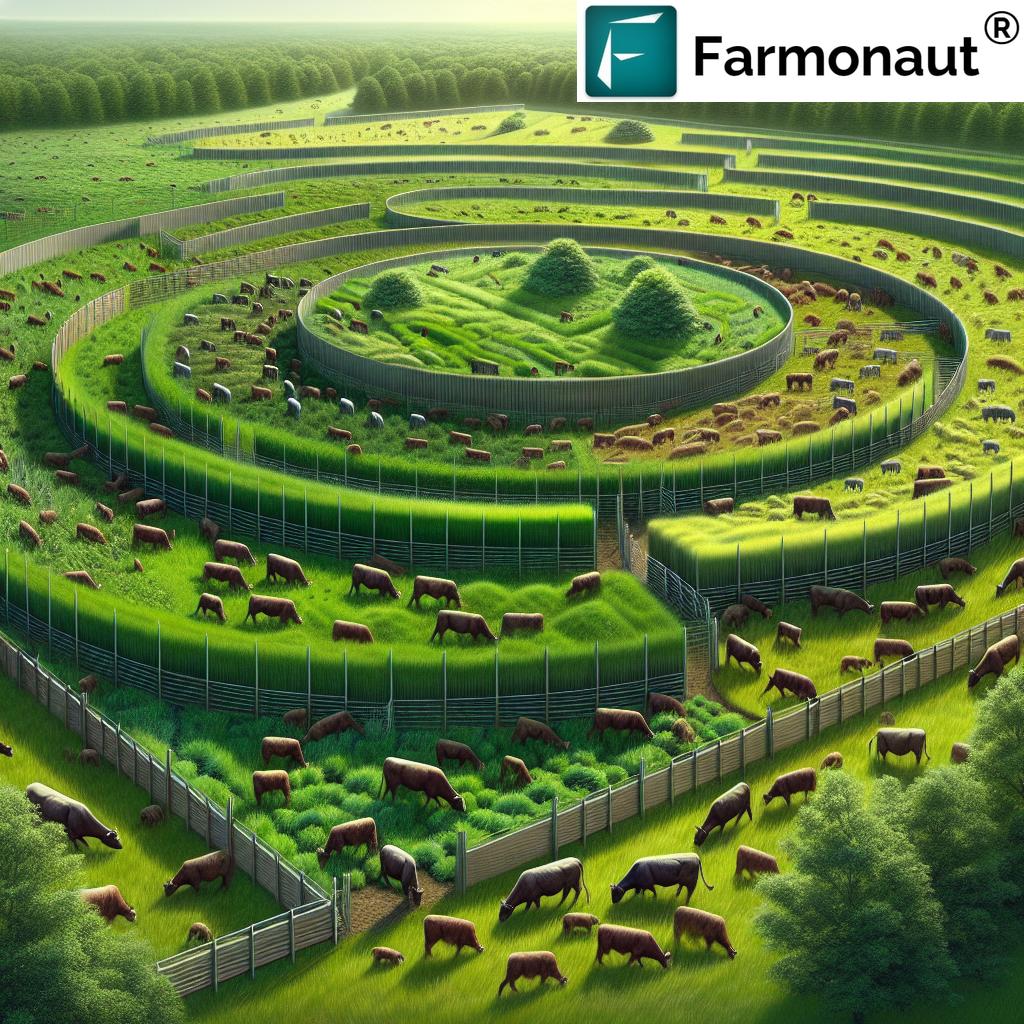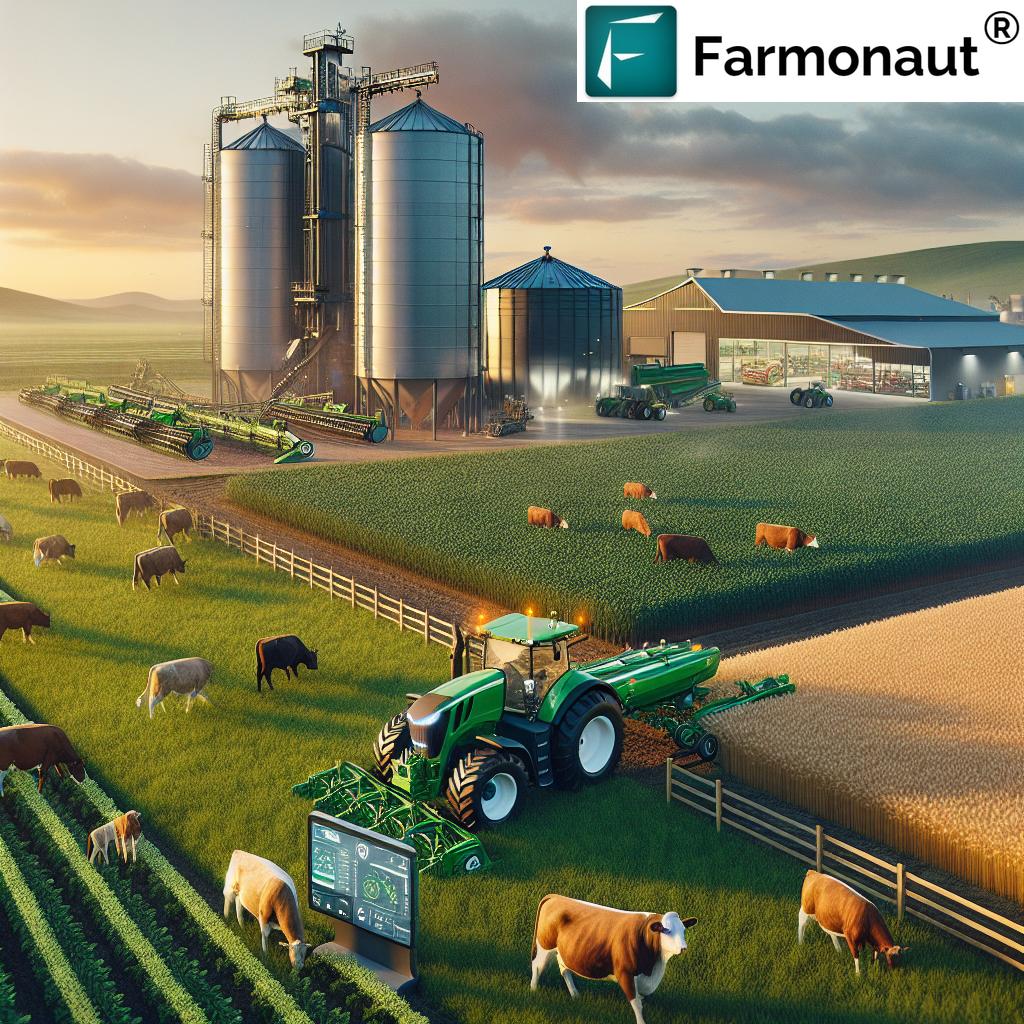Unlocking Wool Market Trends: Essential Industry Statistics and Sustainability Insights
“The global wool market is valued at over $30 billion annually, with Australia producing 25% of the world’s wool.”
Welcome to our comprehensive exploration of the wool market landscape, where we delve into the latest trends, crucial statistics, and sustainability initiatives shaping this dynamic industry. At Farmonaut, we understand the importance of staying informed in the rapidly evolving world of agriculture, and today, we’re focusing on one of the most versatile natural fibers: wool.
As a leading provider of agricultural technology solutions, we recognize the challenges faced by wool producers, buyers, and analysts in navigating the complex market environment. That’s why we’ve compiled this in-depth guide to help you unlock the potential of wool market trends and gain valuable insights into sustainable wool production.
The Evolving Landscape of the Global Wool Market
The wool industry has undergone significant transformations in recent years, driven by changing consumer preferences, technological advancements, and a growing emphasis on sustainability. Let’s explore some key aspects of this evolving landscape:
- Market Dynamics: Understanding supply and demand fluctuations
- Price Trends: Analyzing factors influencing wool pricing
- Sustainability Initiatives: Exploring eco-friendly wool production methods
- Technological Innovations: Examining the role of agtech in wool farming
As we navigate these topics, we’ll provide you with essential wool industry statistics, market indicators, and insights into sustainable wool production practices. Our goal is to equip you with the knowledge needed to make informed decisions in this ever-changing market.
Essential Wool Industry Statistics
To gain a comprehensive understanding of the wool market, it’s crucial to examine key industry statistics. These numbers provide valuable insights into production volumes, trade patterns, and market trends. Let’s dive into some of the most important figures:
- Global Wool Production: Annual output and regional distribution
- Top Producing Countries: Market share and production capacity
- Export and Import Data: Major players in the international wool trade
- Price Fluctuations: Historical data and current market rates
By analyzing these statistics, we can identify emerging trends and potential opportunities in the wool market. For instance, shifts in production volumes or changes in export patterns can significantly impact pricing and availability.

Sustainable Wool Production: A Growing Priority
Sustainability has become a cornerstone of modern agriculture, and the wool industry is no exception. As consumers increasingly demand eco-friendly products, producers are adopting more sustainable practices. Here are some key areas of focus in sustainable wool production:
- Animal Welfare: Ensuring ethical treatment of sheep
- Land Management: Implementing regenerative farming techniques
- Water Conservation: Reducing water usage in wool processing
- Carbon Footprint: Minimizing emissions throughout the supply chain
At Farmonaut, we’re committed to supporting sustainable agriculture through our innovative technology solutions. Our satellite-based monitoring systems and AI-driven insights help wool producers optimize their operations while minimizing environmental impact.
Explore Farmonaut’s Sustainable Farming Solutions
Wool Market Indicators: Navigating Price Trends
Understanding wool market indicators is essential for anyone involved in the industry. These indicators provide valuable insights into price trends, quality assessments, and market demand. Let’s explore some of the most important wool market indicators:
- Eastern Market Indicator (EMI): A key benchmark for Australian wool prices
- Micron Price Guide: Tracking prices for different wool fiber diameters
- Wool Production Forecasts: Projections for future supply levels
- Consumer Demand Index: Measuring shifts in wool product popularity
By closely monitoring these indicators, producers and buyers can make more informed decisions about when to sell or purchase wool. At Farmonaut, we provide up-to-date market information through our comprehensive agricultural market reports, helping you stay ahead of the curve.
“Sustainable wool production has increased by 40% in the last decade, driven by consumer demand for eco-friendly textiles.”
Precision Agriculture for Wool Production
The application of precision agriculture techniques in wool production is revolutionizing the industry. By leveraging advanced technologies, producers can optimize their operations and improve wool quality. Here are some ways precision agriculture is benefiting wool farmers:
- Satellite Imagery: Monitoring pasture health and grazing patterns
- Soil Analysis: Optimizing nutrient management for better wool quality
- Weather Forecasting: Making informed decisions about shearing and grazing
- Flock Management: Using RFID technology for individual sheep tracking
Farmonaut’s cutting-edge agtech subscription services offer wool producers access to these advanced tools, enabling them to enhance productivity and sustainability.
Discover Farmonaut’s API for Custom Agricultural Solutions

Wool Sustainability Schemes: Ensuring Ethical Production
As the demand for sustainable and ethically produced wool continues to grow, various sustainability schemes have emerged to certify responsible wool production. These initiatives play a crucial role in promoting best practices and ensuring transparency in the wool supply chain. Let’s examine some prominent wool sustainability schemes:
- Responsible Wool Standard (RWS): Certifying animal welfare and land management practices
- ZQ Merino: Focusing on ethical wool production in New Zealand
- Sustainable Cape Wool Standard: Promoting responsible wool farming in South Africa
- GOTS (Global Organic Textile Standard): Certifying organic wool production
These schemes not only provide assurance to consumers but also help producers differentiate their products in the market. At Farmonaut, we support wool producers in meeting these sustainability standards through our advanced monitoring and management tools.
Essential Information Sources for Wool Market Participants
Staying informed is crucial in the fast-paced wool market. Here are some valuable information sources that industry participants should regularly consult:
- Weekly Market Reports: Providing up-to-date pricing and trend analysis
- Annual Wool Statistics Publications: Offering comprehensive industry overviews
- Auction Sale Results: Detailing recent wool sales and price trends
- Industry Conferences and Webinars: Sharing expert insights and forecasts
Farmonaut’s agricultural market reports combine these essential information sources with our proprietary data analytics, providing you with a comprehensive view of the wool market landscape.
Explore Our API Developer Docs for Custom Market Insights
Global Wool Market Trends and Sustainability Indicators
| Country/Region | Annual Wool Production (tonnes) | Market Share (%) | Average Wool Price ($/kg) | Sustainability Score (1-10) | Mulesing-Free Wool (%) | Carbon Footprint (kg CO2e/kg wool) |
|---|---|---|---|---|---|---|
| Australia | 350,000 | 25 | 12.50 | 8 | 15 | 24 |
| New Zealand | 140,000 | 10 | 11.75 | 9 | 100 | 20 |
| China | 120,000 | 8.5 | 9.80 | 6 | 5 | 28 |
| South America | 85,000 | 6 | 10.20 | 7 | 40 | 22 |
Customized Wool Market Reports: Tailored Insights for Your Business
In the diverse world of wool production and trading, one size doesn’t fit all when it comes to market intelligence. That’s why customized reports are becoming increasingly valuable. These tailored analyses can provide:
- Region-specific market trends and forecasts
- Detailed analysis of specific wool grades or types
- Supply chain insights for your particular market segment
- Sustainability performance metrics relevant to your operations
At Farmonaut, we understand the importance of personalized market intelligence. Our team of experts can create customized wool market reports that address your specific needs and help you make data-driven decisions.
Staying Ahead with Daily Updates
In the fast-paced wool market, daily updates can make a significant difference in decision-making. Here’s how you can stay informed on a day-to-day basis:
- Exchange Rate Monitoring: Track currency fluctuations affecting wool prices
- Price Schedules: Access daily updated wool price listings
- Market Messages: Receive concise daily summaries of market movements
- Weather Alerts: Stay informed about conditions affecting wool production
Farmonaut’s platform provides these daily updates, ensuring you have the most current information at your fingertips. Our mobile apps make it easy to access this vital data on the go.
Download Farmonaut Apps for Instant Market Updates:
Mulesing Status: A Key Consideration in Wool Sustainability
Mulesing, a controversial practice in sheep farming, has become a significant factor in wool sustainability discussions. Here’s what you need to know:
- Definition: Mulesing is the removal of skin from around a sheep’s breech to prevent flystrike
- Consumer Concerns: Growing demand for mulesing-free wool due to animal welfare considerations
- Alternative Practices: Breeding programs and other methods to reduce flystrike risk
- Market Impact: Price premiums for certified non-mulesed wool in some markets
Tracking mulesing status has become crucial for many buyers and consumers. Farmonaut’s traceability solutions can help wool producers document and verify their mulesing practices, meeting the increasing demand for transparency in the supply chain.
National Wool Statistics: Understanding the Bigger Picture
National wool statistics provide valuable insights into the overall health and trends of the wool industry within specific countries. These statistics typically cover:
- Production Volumes: Total wool clip and trends over time
- Flock Size: Number of sheep and changes in livestock populations
- Export Data: Volume and value of wool exports
- Quality Metrics: Distribution of wool by micron and other characteristics
By analyzing these national statistics, industry participants can gain a broader understanding of market dynamics and make more informed long-term decisions. Farmonaut’s comprehensive reports incorporate these national statistics, providing context to our more detailed market analyses.
Leveraging Farmonaut’s Solutions for Wool Market Success
As we’ve explored the complexities of the wool market, it’s clear that staying informed and leveraging technology are key to success in this industry. Farmonaut’s suite of tools and services can help you navigate these challenges:
- Satellite-Based Monitoring: Optimize pasture management and wool production
- AI-Driven Insights: Make data-informed decisions about flock management
- Market Intelligence Reports: Stay updated on the latest wool market trends
- Sustainability Tracking: Monitor and improve your environmental performance
By integrating these solutions into your wool production or trading operations, you can enhance efficiency, sustainability, and profitability.
Explore Farmonaut’s Web App for Comprehensive Wool Market Insights
Farmonaut Subscription Options
Frequently Asked Questions
Q: What are the key factors influencing wool prices?
A: Wool prices are influenced by various factors, including global supply and demand, currency exchange rates, fashion trends, and economic conditions in major consuming countries. Additionally, factors such as fiber quality, micron count, and sustainability certifications can impact pricing.
Q: How can I stay updated on daily wool market movements?
A: Farmonaut offers daily market updates through our mobile apps and web platform. These updates include exchange rate information, price schedules, and concise market messages to keep you informed of the latest developments.
Q: What role does sustainability play in the modern wool market?
A: Sustainability has become increasingly important in the wool market, with consumers and brands demanding more environmentally friendly and ethically produced wool. This has led to the development of various sustainability schemes and certifications, as well as increased focus on practices such as regenerative agriculture and animal welfare.
Q: How can Farmonaut’s solutions benefit wool producers?
A: Farmonaut offers a range of tools and services that can benefit wool producers, including satellite-based pasture monitoring, AI-driven insights for flock management, and comprehensive market intelligence reports. These solutions can help optimize production, improve sustainability, and make more informed business decisions.
Q: What are some key wool industry statistics to monitor?
A: Important statistics to monitor include global and regional production volumes, export and import data, price trends for different wool grades, and sustainability metrics such as the percentage of mulesing-free wool. National flock sizes and wool quality distributions are also valuable indicators of industry trends.
Conclusion: Embracing the Future of Wool Production
As we’ve explored throughout this comprehensive guide, the wool market is a dynamic and evolving landscape that requires constant attention and adaptation. From understanding crucial wool industry statistics to embracing sustainable production practices, success in this sector demands a multifaceted approach.
At Farmonaut, we’re committed to providing the tools, insights, and support needed to navigate these complexities. Our advanced agricultural technology solutions, combined with in-depth market analysis, empower wool producers, buyers, and analysts to make informed decisions and stay ahead of industry trends.
By leveraging precision agriculture techniques, staying informed through comprehensive market reports, and prioritizing sustainability, you can position yourself for success in the global wool trade. Remember, in today’s interconnected world, staying informed is not just an advantage – it’s a necessity.
We invite you to explore Farmonaut’s suite of solutions and discover how our technology can transform your approach to wool production and market analysis. Together, we can unlock the full potential of the wool industry while promoting sustainable and ethical practices.
Ready to revolutionize your approach to wool production and market analysis? Explore Farmonaut’s solutions today:
Join us in shaping the future of sustainable wool production and market intelligence. With Farmonaut, you’re not just keeping up with the industry – you’re leading the way.















